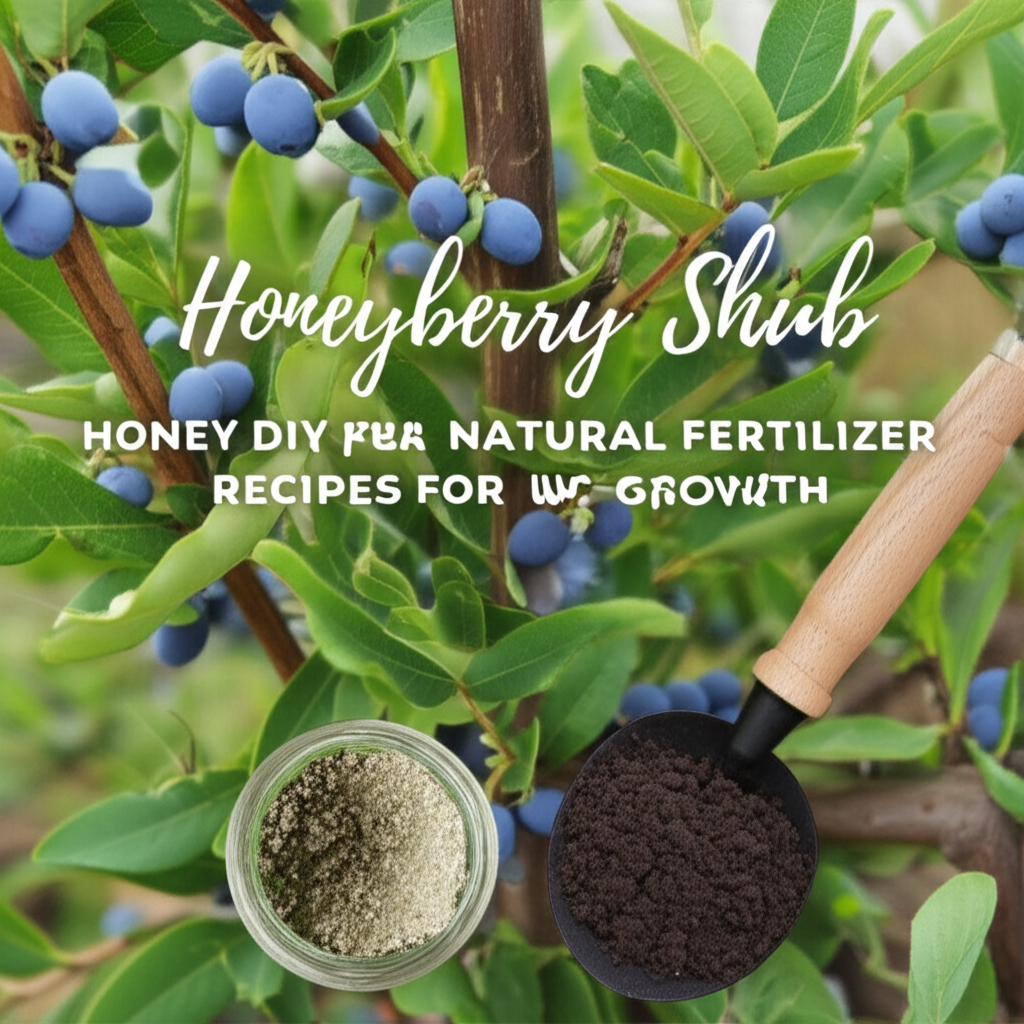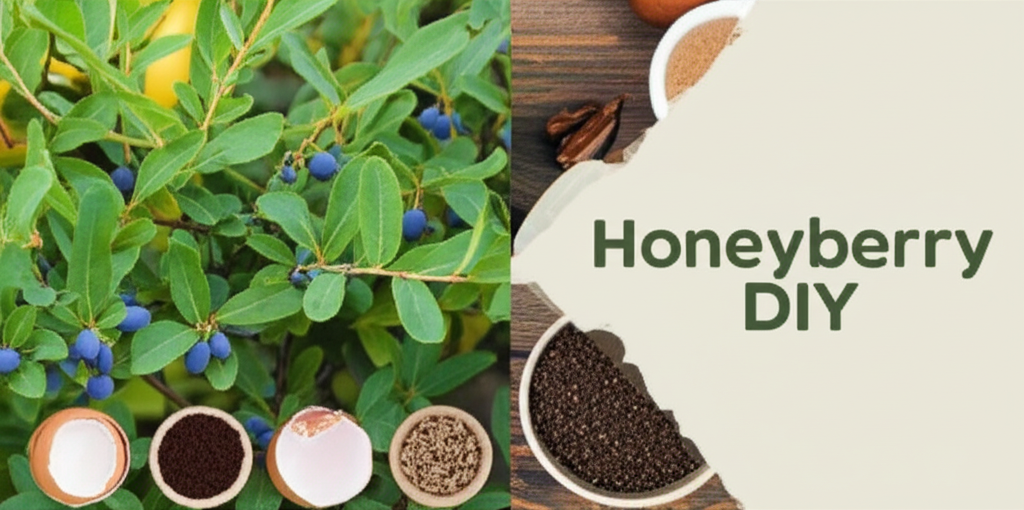Unlock the Potential of Your Honeyberry Bushes with Natural Fertilizers
Honeyberry bushes, also known by their scientific name Lonicera caerulea or the common name Haskap, are becoming increasingly popular in home gardens. These hardy, cold-tolerant shrubs offer delicious, antioxidant-rich berries that ripen early in the season, often before strawberries. To ensure your honeyberry plants thrive and produce bountiful harvests, providing them with the right nutrients is crucial. While commercial fertilizers are readily available, embracing DIY natural fertilizer recipes offers a more sustainable, cost-effective, and environmentally friendly approach. This guide will delve into crafting effective natural fertilizers to promote robust growth, abundant fruiting, and overall health for your honeyberry shrubs.
Why Choose Natural Fertilizers for Honeyberries?
The advantages of opting for natural fertilizers over synthetic alternatives are manifold. For honeyberry bushes, this means fostering a healthier soil ecosystem, encouraging beneficial microbial activity, and avoiding the risk of chemical burn or nutrient imbalances that can plague over-fertilized plants. Natural fertilizers also release nutrients gradually, providing a steady supply to the plant over time, which is ideal for sustained growth. Furthermore, many natural fertilizer ingredients are readily available in your own home or garden, reducing waste and your environmental footprint.
Understanding Honeyberry Nutrient Needs
Before we dive into specific recipes, it’s essential to understand what nutrients honeyberries require for optimal health. Like most fruiting plants, honeyberries benefit from a balanced supply of macronutrients:
- Nitrogen (N): Crucial for vegetative growth, leaf development, and overall plant vigor. Too little nitrogen can lead to pale, stunted leaves, while too much can promote excessive leafy growth at the expense of fruit production.
- Phosphorus (P): Essential for root development, flowering, and fruit set. Adequate phosphorus promotes strong root systems and increases the yield and quality of berries.
- Potassium (K): Plays a vital role in disease resistance, water regulation, and fruit development, including sugar content and flavor.
Honeyberries also require micronutrients in smaller amounts, such as calcium, magnesium, sulfur, iron, zinc, manganese, copper, boron, and molybdenum. These micronutrients are often present in organic materials and are typically supplied through composting and the use of natural soil amendments.
Key Natural Fertilizer Ingredients for Honeyberry Growth

Many common household and garden items can be transformed into potent, natural fertilizers for your honeyberry bushes. Here are some of the most effective ingredients:
Compost: The Foundation of Natural Fertilization
Compost is arguably the most valuable soil amendment and natural fertilizer you can provide for your honeyberries. It’s a rich source of a wide spectrum of nutrients, improves soil structure, enhances water retention, and supports beneficial soil organisms.
Types of Compost and Their Benefits
- Kitchen Scraps Compost: Made from fruit and vegetable peels, coffee grounds, tea bags, and eggshells. Rich in nitrogen and potassium.
- Yard Waste Compost: Composed of leaves, grass clippings, and small twigs. Provides a good balance of nutrients and improves soil aeration.
- Manure Compost: Well-rotted animal manure (cow, horse, chicken) is a powerhouse of nutrients, particularly nitrogen and phosphorus. Ensure it is thoroughly composted to avoid burning plants.
Coffee Grounds: A Nitrogen Boost
Used coffee grounds are a fantastic natural fertilizer, particularly for nitrogen. They are slightly acidic, which honeyberries can tolerate, and they also help to attract earthworms, which further enrich the soil.
Eggshells: Calcium for Strong Growth
Crushed eggshells are an excellent source of calcium, vital for cell wall development in plants. Calcium strengthens the plant structure, improves fruit quality, and can help prevent blossom-end rot (though less common in honeyberries than in tomatoes).
Banana Peels: Potassium Powerhouse
Banana peels are incredibly rich in potassium, which is essential for flower and fruit development. They also contain calcium and magnesium.
Epsom Salts: Magnesium and Sulfur Source
Epsom salts (magnesium sulfate) are a natural mineral that provides magnesium and sulfur. Magnesium is a core component of chlorophyll, essential for photosynthesis, while sulfur aids in nutrient uptake and protein synthesis.
Wood Ash: Potassium and pH Adjuster
Wood ash, from untreated wood fireplaces or bonfires, is a good source of potassium and calcium. However, it is alkaline, so it should be used sparingly and with caution, especially if your soil is already alkaline. It can help raise the pH of acidic soils.
Other Beneficial Amendments
- Alfalfa Meal: A nitrogen-rich fertilizer that also provides trace minerals and growth stimulants.
- Bone Meal: A good source of phosphorus and calcium, ideal for promoting root and flower development.
- Fish Emulsion/Seaweed Extract: Provide a broad spectrum of nutrients, including micronutrients, and are readily absorbed by plants.
DIY Natural Fertilizer Recipes for Honeyberry Bushes
Here are some practical, easy-to-make DIY natural fertilizer recipes tailored for your honeyberry shrubs.
Recipe 1: The All-Purpose Compost Boost
This is your foundational fertilizer, best applied annually in early spring.
Ingredients:
- A generous shovelful of well-rotted compost
- 1 cup used coffee grounds
- 1/2 cup crushed eggshells
Instructions:
- Mix the compost, coffee grounds, and crushed eggshells thoroughly.
- Gently spread a layer of this mixture around the base of your honeyberry bush, keeping it a few inches away from the main stem.
- Water the area well to help the nutrients begin to break down and absorb into the soil.
Recipe 2: The Potassium Power Punch (Mid-Season Boost)
This recipe is ideal for application in late spring or early summer, when the plant is transitioning from vegetative growth to flowering and fruit development.
Ingredients:
- 2-3 banana peels, chopped
- 1 tablespoon Epsom salts
- 1/4 cup alfalfa meal
Instructions:
- Chop the banana peels into small pieces. You can either bury them directly around the plant or dry them and then grind them into a powder.
- In a small bucket, mix the chopped banana peels, Epsom salts, and alfalfa meal with a few liters of water.
- Let the mixture steep for 24-48 hours, stirring occasionally.
- Strain the liquid (optional, but recommended to avoid clogging watering cans) and use it to water your honeyberry bushes.
- You can also bury the strained solids around the base of the plant.
Recipe 3: The pH Balancing Brew (Use Sparingly)
If you suspect your soil might be too acidic, a small amount of wood ash can be beneficial. This should only be used occasionally, perhaps once every 1-2 years, and only after testing your soil’s pH.
Ingredients:
- 1/4 cup fine wood ash (from untreated wood)
- 1 cup compost
Instructions:
- Mix the wood ash and compost together thoroughly.
- Apply this mixture very lightly around the base of the honeyberry bush, especially if your soil is on the acidic side.
- Water in well.
- Caution: Do not use wood ash on plants that prefer acidic soil, or if your soil pH is already neutral or alkaline. Overuse can lead to nutrient deficiencies.
Application and Timing for Honeyberry Fertilization
The best time to fertilize your honeyberry bushes is in early spring as the plants begin to emerge from dormancy and new growth starts. A second, lighter feeding can be beneficial in late spring or early summer to support fruit development. Avoid fertilizing late in the growing season, as this can encourage new growth that may not harden off before winter, making it susceptible to frost damage.
When to Fertilize: A General Guideline
- Early Spring (March-April): Apply your all-purpose compost-based fertilizer. This is the most important feeding.
- Late Spring/Early Summer (May-June): Apply a potassium-rich fertilizer or a dilute liquid feed to support flowering and fruiting.
How to Apply
- Top Dressing: Spread granular or compost-based fertilizers around the base of the plant, extending out to the drip line (the outer edge of the branches).
- Liquid Feeding: Dilute liquid fertilizers (like steeped banana peel tea or fish emulsion) and use them to water the plants. This provides a quick nutrient boost.
- Incorporation: Gently work light amendments into the top inch or two of soil, being careful not to disturb the shallow root system of honeyberry plants.
Key Facts and Comparison of Natural Fertilizers
Here’s a quick reference table to help you understand the primary benefits of common natural fertilizer ingredients for your honeyberry bushes:
| Natural Fertilizer Ingredient | Primary Nutrients Provided | Key Benefits for Honeyberries | Best Application Time |
|---|---|---|---|
| Compost | N, P, K, Micronutrients | Improves soil structure, water retention, provides balanced nutrition | Early Spring |
| Coffee Grounds | Nitrogen (N) | Promotes leafy growth, attracts earthworms | Spring/Summer |
| Eggshells | Calcium (Ca) | Strengthens cell walls, improves fruit quality | Spring |
| Banana Peels | Potassium (K), Calcium (Ca), Magnesium (Mg) | Supports flowering and fruiting, improves berry flavor | Late Spring/Early Summer |
| Epsom Salts | Magnesium (Mg), Sulfur (S) | Enhances chlorophyll production, improves nutrient uptake | Late Spring/Early Summer (if magnesium deficiency is suspected) |
| Wood Ash | Potassium (K), Calcium (Ca) | Can raise soil pH, provides potassium | Sparingly, only if soil is acidic (once every 1-2 years) |
| Alfalfa Meal | Nitrogen (N), Trace Minerals | Provides slow-release nitrogen, acts as a mild growth stimulant | Spring |
Troubleshooting and Best Practices
While natural fertilizers are generally forgiving, a few best practices can ensure optimal results and prevent potential issues.
Pros and Cons of DIY Natural Fertilizers for Honeyberries
Let’s summarize the advantages and disadvantages of using these homemade nutrient boosters.
| Pros | Cons |
|---|---|
| Environmentally friendly and sustainable | Nutrient content can be variable and less precise than commercial fertilizers |
| Cost-effective, utilizing household waste | May require larger volumes for equivalent nutrient delivery compared to concentrated synthetics |
| Improves soil health and structure over time | Some ingredients may require preparation (e.g., drying, grinding) |
| Reduces reliance on chemical inputs, promoting healthier plants and ecosystem | Potential for over-application if not careful (e.g., wood ash) |
| Gentle on plants, reducing risk of fertilizer burn | Some ingredients may attract pests if not properly incorporated or composted |
Important Considerations
- Soil Testing: Periodically testing your soil’s pH and nutrient levels can help you tailor your fertilizer applications more effectively. Honeyberries generally prefer slightly acidic to neutral soil (pH 5.5-7.0).
- Observation is Key: Pay attention to your honeyberry bushes. Yellowing leaves might indicate a nitrogen deficiency, while poor flowering could suggest a need for more phosphorus or potassium.
- Mulching: After fertilizing, apply a layer of organic mulch (like wood chips, straw, or compost) around your honeyberry bushes. Mulch helps retain soil moisture, suppress weeds, and regulate soil temperature, all of which contribute to healthy plant growth.
- Watering: Ensure your plants are adequately watered, especially after applying fertilizers. This helps the nutrients dissolve and be absorbed by the roots.
- Composting Practices: If you are making your own compost, ensure it is fully decomposed before applying it to your plants to avoid introducing weed seeds or pathogens.
By incorporating these DIY natural fertilizer recipes and best practices, you can nurture your honeyberry shrubs into healthy, productive plants that will reward you with delicious berries season after season. Happy gardening!


